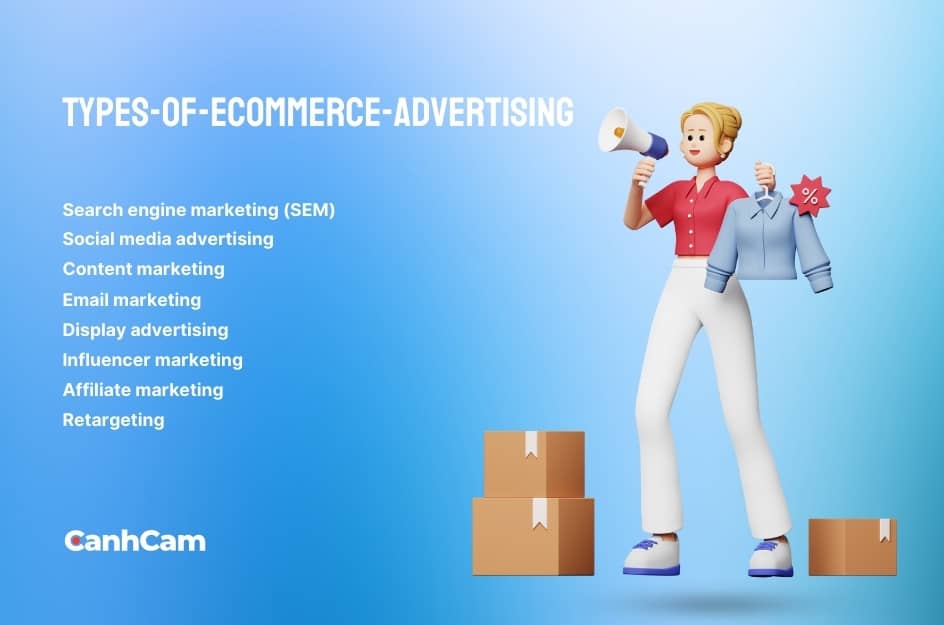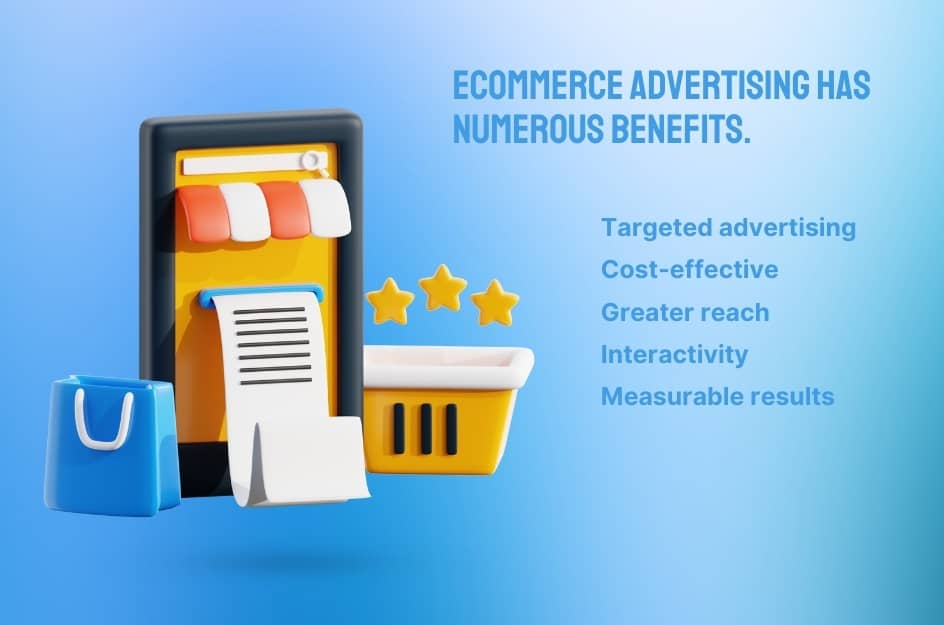Did you know that in today's digital world, the success of an ecommerce joint venture depends largely on the advertising strategy the enterprises come up with? Digital marketing has been of utmost importance in the era of e-commerce.
In the era of e-commerce advertising, where the electronic world presents unlimited options to businesses in highlighting their products and services, e-commerce advertising is unavoidable till the digital age.
Through designing an effective marketing program, companies can reach their prospects, improve the brand name, boost sales, and cut down on marketing expenditures.
CanhCam wishes this article would help give you the necessary information about the significance and techniques to construct an ecommerce advertising strategy that is successful.
What is Ecommerce Advertising?
E-commerce advertising is the development of products or services via different varieties of digital channels carrying out traffic, sales and ROI (Return on Investment) of online businesses as a result. It constitutes a set of defined strategies and tactics tailored to the digital environment, where consumers are relying more and more on the internet to look up information and make online purchases.
E-commerce advertising is like attention to your web store in the overwhelming ocean of the internet. Digital marketing can help you make your product or service visible to the right people at the exact preferred time which is by intelligent digital techniques that help sales and differentiate you from others. And it is your secret weapon to rally and make money in the stormy ocean of online shopping.
Visit Our Services: Small business website design Melbourne

Types of Ecommerce Advertising
To help you understand what an e-commerce marketing strategy looks like, here are some popular marketing channels and how you can use them to build your online store:
Search Engine Marketing (SEM)
SEM involves positioning your ad on the search engine result pages (SERPs) to make it more visible and to drive traffic to your webpage. Such ads are usually on the top or bottom of search results and are activated by particular keywords that are related to your goods or services.
Social Media Advertising
Social media advertising has taken an essential place for e-commerce businesses to get an audience and to make sales. Facebook, Instagram, Twitter, and LinkedIn provide different ad formats, such as sponsored posts, display ads, and video ads, allowing small businesses to choose who they want to advertise to based on demographics, interests, and behaviour.
Content Marketing
Content marketing revolves around the process of developing informative and relevant content like blog posts, articles, videos, and infographics to get and target audience. Through creating informative and entertaining content, companies can become the authority in the industry, build a trusting audience, and increase their organic online traffic to the e-commerce website.

Ecommerce advertising types: SEM, social media, display, email, affiliate, influencer.
Email Marketing
Among digital marketing strategies, email marketing is still an outstanding tactic in nurturing leads, promoting products, and driving sales. Through an email list of opt-in subscribers, businesses are able to send customized and personalized emails to nudge sales, alert promotions, and establish customer loyalty.
Display Advertising
Display advertising includes the displaying of visual ads, e.g. banners on web pages or apps to boost brand awareness and drive traffic to your e-commerce website. These ads are capable of being targeted through the use of factors such as demographics, preferences, and web browsing behaviour thus enabling businesses to hit their target audience.
Read more: What is Shopify Audiences & How Does it Work
Influencer Marketing
Influencer marketing has emerged as a popular e-commerce advertising strategy, especially on social media platforms like Instagram and YouTube. By collaborating with influential individuals with a loyal following, businesses can leverage their influence to authentically promote their products or services and reach new customers.
Affiliate Marketing
Affiliate marketing is a type of marketing where you collaborate with third-party affiliates which can be bloggers, influencers, and content creators, who promote your products and services indirectly through their referral links and you pay them a commission upon your sales which have been made through their links. The performance-based advertising model allows businesses to enlarge their audience and create sales without bearing upfront expenses.
Retargeting
Retargeting which is also known as re-marketing is an important ecommerce advertising tactic that involves displaying ads to users who have previously visited your ecommerce website or interacted with your brand online. Ad retargeting reinforces the recall of products users have previously interacted with. As a result, businesses can prompt their customers to revisit their site and make a purchase, which in turn will lead to a rise in conversion rates and ROI.
These only stand for a few e-commerce advertising strategies, which are available to businesses. When assessing different advertising avenues and customizing them to match their particular plans and audience specifications, businesses can better increase traffic to their site, raise sales, and create an effective online presence.
What are the Benefits of Ecommerce Advertising?
E-commerce advertising is a bundle of incredible opportunities for businesses trying to excel in the digital era. Let us now examine some of the main advantages which e-commerce advertising has become inevitable for growth and success.
Targeted Advertising
E-commerce ads have the unique capacity for reaching the customers that will eventually make the purchase. Unlike the conventional approach, it provides the opportunity for companies to target audiences based on their age, interests, and behaviours. This high-precision targeting ensures great effectiveness and above all increases conversion rates.
Cost-Effective
Compared to traditional channels like print or television, e-commerce advertising offers unmatched cost-effectiveness. Digital platforms allow businesses to set budgets, choose bidding strategies, and track ROI in real-time. Various payment models like pay-per-click (PPC) or cost-per-acquisition (CPA) enable optimization of spending for maximum returns.

Ecommerce advertising boosts sales and engages customers effectively.
Greater Reach
E-commerce advertising breaks down geographical barriers, enabling businesses to reach customers globally. Through search engines, social media, or affiliate networks, businesses can connect with a broader audience, driving more traffic to their online stores and expanding market reach.
Interactivity
Unlike traditional mediums, e-commerce advertising fosters real-time interaction with audiences. Interactive ads, personalized recommendations, and live chat support create immersive experiences that engage customers. This fosters brand loyalty, trust, and advocacy, building meaningful connections.
Measurable Results
E-commerce advertising has the advantage as it provides measurable results through advanced analytics and tracking tools. The business can see the campaign performance in real-time. They can know metrics like click-through rates and conversion rates. The findings obtained from the analysis usually lead to variation and further improvement of advertising tactics.
Ecommerce advertising is a vital element for companies competing in the ever-expanding digital marketplace. Its focus, cost-effectiveness, global outreach, interactivity, and measurability make it the perfect tool for linking with customers, closing sales, and making the dreams of companies come true.
How to Success in Ecommerce Ad Strategy?
Implementing a top-notch e-commerce advertising strategy is of paramount importance to boost sales and achieve success in the cut-throat online market. Now we can dissect the fundamental elements of an advertising strategy for e-commerce that produces the desired effect.
What Is the Process for Digital E-commerce Advertising?
Digital e-commerce advertising operates on a fundamental yet potent principle: providing the right message to the right audience at the right moment. The process starts with establishing a campaign to determine the company’s goal, audience to be targeted, budget, and advertising content.
Within this time frame, the advertisements are spread across different digital media platforms such as search engines, social media portals, and display networks which use state-of-the-art technology to hit the exact audience and maximize the conversions. Performance metrics are monitored and adjusted by campaign goals all through the process to maximize return on investment and achieve defined objectives.

To excel in ecommerce ad strategy, focus on targeted audience research and craft visually compelling ads for higher conversions.
The Importance of Digital Advertising
Digital advertising plays a crucial role in the success of e-commerce websites for several reasons:
- Enhanced brand awareness: Digital advertising enables businesses to introduce their brand and products to a broader audience, enhancing visibility and recognition in the crowded online marketplace.
- Higher ROI: Compared to traditional advertising channels, digital advertising offers higher returns on investment due to its cost-effectiveness, precise targeting capabilities, and ability to deliver measurable results.
- Attracting qualified leads: Through targeted advertising based on demographics, interests, and specific behaviours, digital e-commerce advertising ensures businesses attract high-quality, relevant leads, consequently increasing conversions and sales.
Optimize ecommerce digital ads to boost sales
Creating a successful e-commerce digital advertising strategy requires careful planning and execution. Here are some key steps to boost revenue through your advertising efforts:
- Highlight brand and product benefits: Focus on communicating the unique value propositions and benefits of your product or service in your ad copy. This approach captures the audience's attention and motivates them to take action.
- Craft Clear and Persuasive CTA: Strong Calls-to-Action (CTAs) prompt users to interact with your ads and take desired actions, whether it's making a purchase, signing up for a newsletter, or requesting more information.
- Collaborate with e-commerce experts: Consider partnering with experienced e-commerce marketing teams to elevate your advertising efforts. These experts can offer strategic guidance, creative expertise, and technical support, helping you maximize advertising effectiveness and drive revenue growth.
By implementing these best practices and strategies, businesses can develop successful e-commerce digital advertising campaigns that not only increase revenue but also enhance brand visibility and deliver measurable results in the fiercely competitive online marketplace.
Conclusion
Ecommerce advertising plays a key role in the success of the digital market, giving businesses powerful tools to develop and prosper. Digital channels are now leveraged by companies to increase their brand visibility, attract the right target audience, and generate more sales in less time, through precision and effectiveness.
From targeted campaigns, cost-efficiency solutions, measurable outcomes, and interactivity, e-commerce advertising provides businesses with an excellent opportunity to link up with their audience, increase sales, and achieve their objectives in the competitive online market.
Ready to revolutionize your e-commerce advertising? Examine the possibility of having the customized winning strategy created by CanhCam's experts tailored to your specific business needs. Contact us today if you are interested in receiving more information about our e-commerce advertising services and start to build your brand online and boost your revenue. Don't let your competitors take away the show, rather let's skyrocket your brand to success hand in hand.
Frequently Asked Questions (FAQs)
1. What is an example of an advertisement model?
An example of a successful model of advertising.
- Cost-Per-Click (CPC) Advertising: This is the most common advertising model. The advertiser only has to pay a fee for each click of their ad.
- Cost-Per-View (CPV) Advertising: This is an advertising model where the advertiser pays a fee for every view of their ad
2. What are popular advertising models?
One of the commonly used advertising frameworks is referred to as AIDA, which represents awareness, interest, desire, and action. This model charts the customer’s path from the initial stage of selecting a product or service to the final stage of making the ultimate buying decision.

